|
Dutch
Barn Preservation Society
Dedicated
to the Study and Preservation
of New World Dutch Barns
NEWSLETTER
Spring 1993, Vol., 6, Issue 1
A
Tale of Two Barns
by John R. Stevens
Photos are by the author unless noted.
In June, 1967 the writer commenced working as an architectural
historian at Old Bethpage Village Restoration on Long Island. This
museum village project had been started a few years earlier by
the Nassau County Museum. He was immediately confronted with a
daunting project - the restoration planning for the Minne Schenck
House, built c.1730 at what later became Manhasset, on the north
shore of Long Island, which was moved to the Restoration. This
Dutch - American house represented a building heritage with which
the writer was largely unfamiliar, although in 1964 he had surveyed
a house at Granville Ferry, Nova Scotia which he later realized
was of Dutch ancestry. This latter house had been built, he found
out, by a New York Loyalist named Amberman, who may have come from
Long Island. There had been a barn at the Nova Scotia site, an
interior photograph of which the writer later obtained, showing
anchor beam construction with extended wedged tenons. In 1964 the
Nova Scotia house was believed to be of French origin, and to date
to the early 1700's!
The writer found the literature about Dutch-American buildings
was exceedingly scanty. There was little written about them except
several picture books of Hudson Valley houses and the largely genealogical
books by Helen Reynolds and Rosalie Fellows Bailey, the first covering
the Hudson Valley and the latter western Long Island, Staten Island,
Rockland County and areas of Dutch settlement in New Jersey. These
books were published by the Holland Society in 1929 and 1934 respectively.
To develop an understanding of the Dutch-American building tradition
so that the Minne Schenck house could be accurately restored, the
writer commenced an intensive study of the construction details,
molding profiles, and so on, of many of the houses covered in the
Reynolds and Bailey books. Other houses of considerable interest
were found along the way that added much to his knowledge.
As time permitted over a period of years, field trips were made
to areas where houses of Dutch ancestry could be found. Houses
were measured and photographed and this information was a great
assistance in the restoration of the Schenck house.
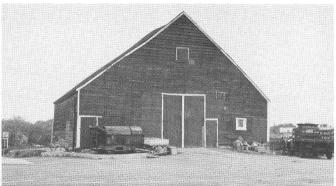
The Van Nastrand-Rattkamp Barn standing
at Elmant, an the Hempstead Turnpike, in 1967.
Through the course of his studies the writer inevitably became
aware of the special kind of barn that was characteristic of the
areas of Dutch settlement. Helping him in this direction was Darrell
Henning, the curator concerned with agricultural interpretation
for the Nassau County Museum. Darrell had studied the few Dutch
barns that had survived on Long Island in some detail, and his
knowledge stimulated the writer to an interest in them. One of
the finest of the Long Island barns was the four-bay Van Nostrand
barn which was located on the north side of Hempstead Turnpike
(Route 24) in Elmont, about a mile east of the New York City line.
It was owned by a farmer named Rottkamp and used for agricultural
purposes. This barn would make an excellent addition to the Schenck
house site at Old Bethpage Village Restoration. A large barn, presumably
of Dutch type, was known to have existed at the original site of
the Schenck house at Manhasset. Regrettably, the Van Nostrand barn
was not available at that time, not was it to be in the foreseeable
future.
On July 6, 1968, while driving from Cooperstown to New York on
Route 20, the writer noticed, on the north side of the highway
a short distance west of Carlisle, a rather dilapidated barn very
similar in size and shape to the Van Nostrand barn. An inspection
of its interior revealed a fine Dutch frame, again similar to that
of the Van Nostrand barn, in excellent condition. A year later,
the writer purchased a copy of the late Dr. John Fitchen's 1968
book, The New World Dutch Barn (Syracuse University Press),
which, in addition to opening a new vista on the number and variety
of surviving Dutch barns, illustrated the barn he had seen, and
identified it as the "East of Sharon" barn. (Fitchen,
No. 33; drawings 4G, 5G, 17C; plates I, 2, 31-33) Inquiries made
in the area elicited the information that the barn was owned by
Mr. Walter Quackenbush. The writer informed Mr. Edward Smits, the
Director of the Nassau County Museum, about the barn and recommended
its acquisition for the Schenck house site inasmuch as it seemed
unlikely that a Long Island Dutch barn would become available.
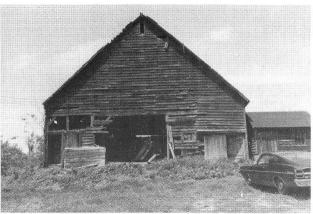
The East of Sharon Barn on its site
west of Carlisle in 1969. It measured 45 feet in width and 40
feet in depth. The ridge ran the shorter distance, in a north-south
orientation. Photo by Charles Tichy.
Mr. Quackenbush was contacted and agreed to donate his barn to
the Museum. It was dismantled by the Old Bethpage Village carpentry
crew and moved to Long Island in September, 1969. It was re-erected
in 1971, a number of the bents being raised by the E.W. Howell
construction crew on May 14 on the occasion of the annual meeting
of the Early American Industries Association which was held at
the Old Bethpage Village Restoration site. Work on the barn was
completed in August, 1971 except for the installation of the hinges
on the large doors. The west gable (south gable on its original
site) was unfortunately struck twice by lightning before lightning
arrestors were installed.
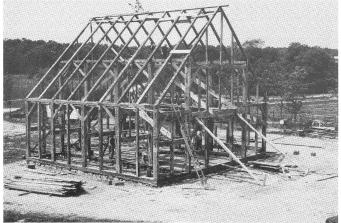
The frame of the Schenck-East of Sharon Barn after
reconstruction at Bethpage Village Restoration, June, 1971.
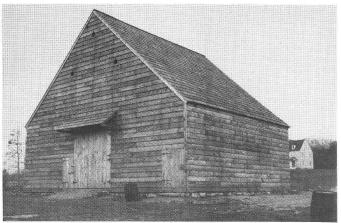
The completed Schenck-East of Sharon Barn at Bethpage
Village Restoration, December, 1971.
Over the years, the writer occasionally passed the Van Nostrand
barn, which continued in agricultural use and appeared to be well-maintained.
Then in January, 1991, Mr. Smits requested that the writer inspect
the barn and evaluate its condition. The Rottkamps had no further
use for it and the land it sat upon had considerable commercial
value. The writer took advantage of the opportunity to measure
and photograph it so that it could be drawn up for inclusion in
a proposed book on Dutch-American buildings. He stressed to the
museum director the importance of this fine building, which he
considered to be the finest Dutch-American building standing on
its original site on Long Island east of the New York City line.
To save it meant that it would have to be dismantled and moved
to another site. One possibility was that it be taken to Old Bethpage
Restoration and set on the foundation of the Schenck barn, formerly
the "East of Sharon" barn. The latter would be disassembled
and offered for sale. Alternatively, even if the Van Nostrand barn
could not be brought to the Old Bethpage Village site, there were
two other sites where a Dutch barn would be an appropriate addition.
One of these was the Queens County Farm Museum, with its c.1770
Adriance house, located only two-and-a-half miles north of the
barn's site. Another possibility was the Pieter Wyckoff house site
in Brooklyn for which it was hoped to obtain a Dutch barn.
The writer did not hear anything further about the Van Nostrand
barn and assumed that it was "safe." In September, Louis
Caputzal, a Dutch Barn Preservation Society Trustee who has family
connections on Long Island, went to look at the barn and found
that it was gone! The barn had been demolished about two weeks
previously. When the writer visited
the site, nothing was left. The ground surface on which the barn
had stood had been graded, obliterating every trace of its existence.
The writer found the elder Mr. Rottkamp at the site, cutting a
piece of grass along Hempstead Turnpike. Mr. Rottkamp said that
the barn had been broken into on numerous occasions and had been
used as a hangout by "crack" addicts. A demolition permit
was obtained from the Town of Hempstead, and the job was duly carried
out. The Rottkamps had indicated to Mr. Smits that they were interested
in the preservation of the barn, but did not inform Mr. Smits that
they had obtained a permit to destroy it! A sad loss, indeed.
The author, an architectural historian, serves
as historic restoration consultant to the Nassau County Museum.
Excerpts from Architectural
Analysis Report, Schenck-East of Sharon Barn
by John Stevens
Foundation. The ground frame of the building
was supported on a series of stone piers, spaced in accord with
the bents. As the ground sloped down from east to west, there was
a crawl space under the west side of the barn.
Sills. Sills were of oak, each in one length,
mortised and pinned at the corners. There were three inner sills,
two corresponding with the line of the main posts, and one in the
middle of the building. The two side inner sills were let into
the end sills with a half lap dovetail while the center sill had
a full lap dovetail. The side inner sills had a rabbet 3 inches
in width and 1 1/2 inches in depth on the inside edge to receive
the flooring. The center sill had two such rabbets. Transversely,
at each inner bent the three inner sills were supported on oak
sleepers that consisted of tree trunks flattened on two faces.
These in turn were supported on stone piers. Timbers were laid
on these, halfway between the side inner sills and the center sill
to bear under the flooring.
Floor. The center aisle (threshing floor) measured
23 feet in width. It had loose floor boards, 1 1/2 inch in thickness,
laid in the sill rabbets.
Framing. All exterior wall posts were of oak.
The purlin posts, anchor beams and plates were of pine. The side
wall posts were slightly more than 13 feet in height, and about
9 inches square. The purlin posts were slightly over 22 feet in
height. They measured about 9 inches transversely and 12 inches
on the face; slightly less in the end bents.
- The outside wall posts were connected with the purlin posts
by horizontal timbers set at 6 feet 9 inches above the threshing
floor on the west side and at 6 feet on the east side, a difference
not understood.
- The purlin posts were connected at a height of about 11 feet
above the floor by anchor beams. The three inner anchor beams
measured about 12 inches in width by 20 inches in depth. The
end anchor beams were 17 inches in depth. The tenons of the anchor
beams protruded about 12 inches beyond the outside faces of the
purlin posts through which they were mortised. They were each
slotted for two wedges that bore against the face of the posts.
In addition, they were pinned through the post. The ends of the
tenons were shaped in a rough semi-circle. The anchor beams were
also braced to the posts. Braces of the end bents measured 6
feet in length, exclusive of their tenons, while those of the
inner bents measured 4 feet on the west side and 4 feet 6 inches
on the east side, corresponding with the difference in the height
of the side wall ties on each side aisle.
- Additional transverse links were applied to the first, third
and fifth bents from near the top of the side wall posts to the
purlin posts and connecting the purl in posts near their tops.
The protruding tenons of these ties were wedged and shaped in
a rough semi-circle.
- The bents were connected by timbers at the same height as
the lower side wall ties, as well as by the plates. There was
an intermediate post between each bent in the side walls. The
plates were braced to all posts in a regular pattern. Braces
were also applied in the end walls between the horizontal ties
and the posts.
- The rafters were regularly spaced at each bent, with an intermediate
rafter between each of these. The foot of each rafter was made
with a cog that lay in a slot in the side plate and bore against
the tenon of the side wall post. The rafters were mortised and
pinned at the ridge and lay on the purlin without being fastened
to it.
Doors. There had been double wagon doors in each
end wall. They were outward opening and had been hung on wrought
iron strap hinges. The pintles for the north doors were in place.
A pair of doors, possibly original, survived in the north opening,
of three-batten construction with braces, nailed with rose-head
nails. The marks of strap hinges were without the characteristic
Dutch nailing pad. These doors had been secured with hooks and
eyes to a vertical pole that went into a mortise in the underside
of the anchor beam and into a corresponding socket on the floor.
In addition, there had been a door in the south wall at the extreme
east side, to admit animals to the stall area. There was also a
door in the west wall, towards the north end of the barn.
Martin Holes. On the north gable, where part
of the original siding survived, was one of probably three martin
holes. The main part of the opening was 7 inches wide. It had a
pointed top, above which was a small inverted triangle. These openings
were characteristic of Dutch barns of the Upper Hudson and Mohawk
valleys. The shape of the opening in this barn can be found in
a number of other examples.
Roof. The roof was boarded with waney-edged
boards, approximately 6 to 10 inches wide, laid with a space between
them. The shingles probably had an exposure of about 12 inches.
Pent Roof. On each end wall, over the main door
openings and extending about one  foot
six inches beyond them on each side, there had been a shed roof.
The projection of the roof could not be determined. Each of these
roofs had been supported by three horizontal struts, about 4 inches
square, made with tenons that went through mortises in the end
anchor beams. The tenons extended about 10 inches past the inside
face of the anchor beam. A vertical wedge through a mortise in
the tenon bore against the anchor beam to secure the strut. foot
six inches beyond them on each side, there had been a shed roof.
The projection of the roof could not be determined. Each of these
roofs had been supported by three horizontal struts, about 4 inches
square, made with tenons that went through mortises in the end
anchor beams. The tenons extended about 10 inches past the inside
face of the anchor beam. A vertical wedge through a mortise in
the tenon bore against the anchor beam to secure the strut.
Detail of an anchor beam tongue, Van Nostrand-Rottkamp
Barn, February 1991. ->
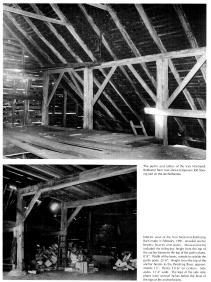
(Click above photo for more views of the Van Nostrand-Rottkamp
Barn.)
NEWSLETTER
Spring 1993, Vol., 6, Issue 1, Part Two
|